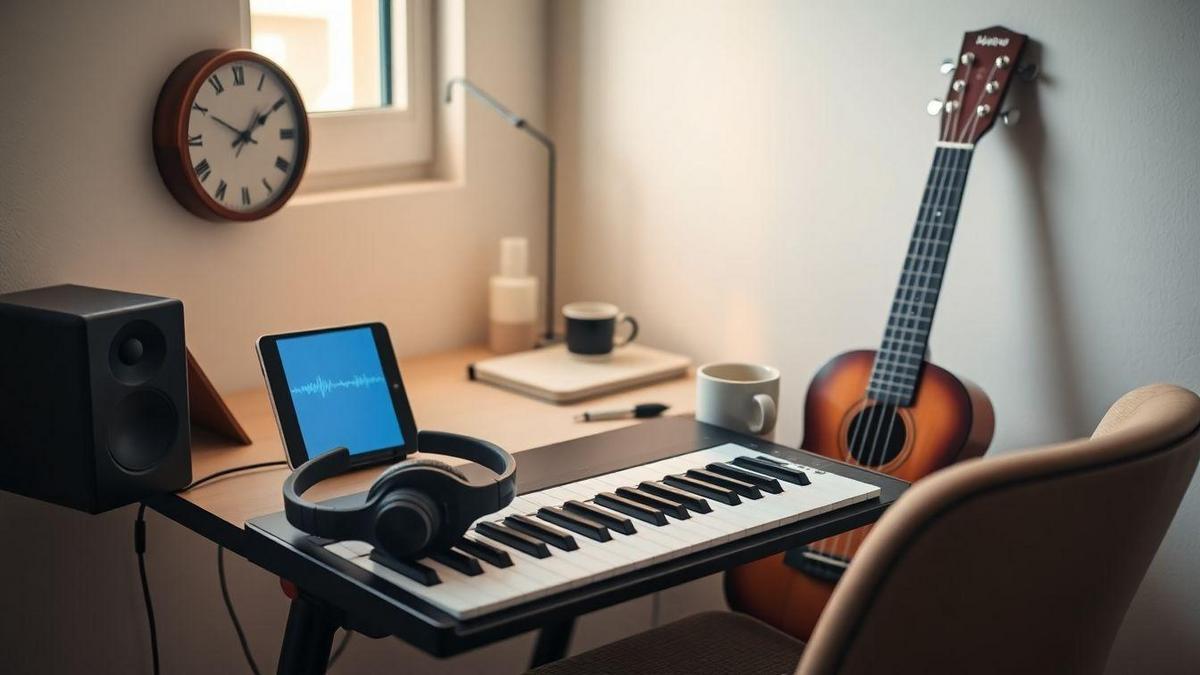Learning music with little free time: yes, it’s possible
I know how it feels to want music in your life but have almost no free hours. Learning music with little free time: yes, it’s possible — by shrinking practice into short, focused habits that stack into real progress. I use short sessions, tiny goals, micro practice, and simple tools (metronome, tuner, slow-down apps) to make every minute count. I track practice and celebrate small wins so I keep going. For a straightforward starting plan, I follow a simple practice routine that fits into my day.
Key takeaway
- Do short practice bursts when time is tight.
- Focus on one clear goal per session to feel progress.
- Break songs into tiny parts and loop the hardest bars.
- Use recordings, slow play, and a metronome for fast feedback.
- Make a simple routine so practice fits your day — small routines often beat long, sporadic sessions (the power of short, regular practice).
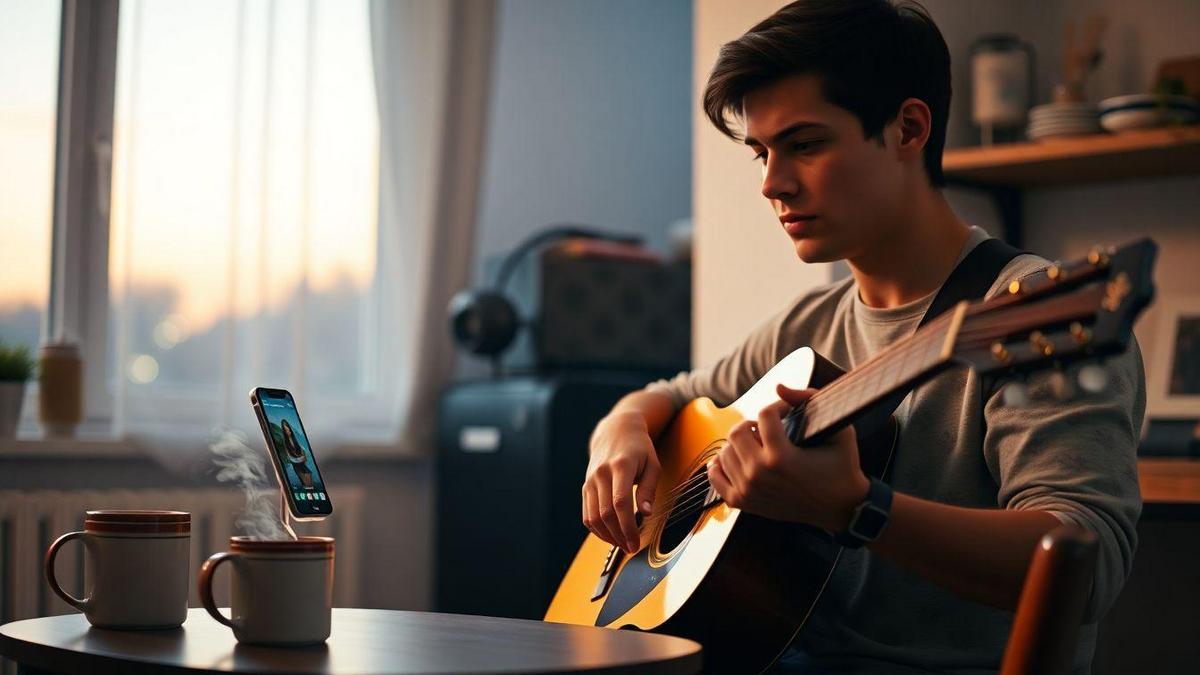
Mindset: small steps, steady gains
Life is packed, but tiny habits win. Treat practice like brushing your teeth: a short, regular habit that keeps your skills healthy. That mental shift — from needing perfect, uninterrupted hours to accepting tiny consistent reps — changed everything for me. Building simple pre-practice rituals helped too (see rituals that help you enter practice mode). For evidence-based habit guidance, see Practical steps to build small habits.
Why short sessions work
- Short bursts lower the barrier to start. Ten focused minutes often beats a distracted hour.
- Quick wins (one riff, one rhythm) boost motivation.
- Less pressure makes showing up easier; skipping feels worse than doing it. If procrastination is the problem, practical steps in how to stop procrastinating on music practice can help.
- Short bursts improve focus, so progress appears faster.
Tiny goals and habit cues
Break big ideas into bite-size targets and attach practice to daily routines.
How I set tiny goals:
- Pick one clear goal (example: play a C major scale cleanly). Learn the basics for scales in scales explained in plain English.
- Limit sessions to 5–15 minutes.
- Repeat the same tiny goal for several days until it feels natural.
- Raise the goal slowly: add speed, a pattern, or dynamics.
- Celebrate small wins (fist bump or a note in a practice log).
Simple cues to make practice automatic:
- Keep your instrument where you see it.
- Practice after a routine (after coffee, lunch, or before bed).
- Use alarms labeled with the tiny task — e.g., 5 min chord work.
- Tick a checklist on your phone and consider keeping a short practice journal.
- Play a song snippet during chores.
Micro-practice techniques: make minutes matter
Learning music with little free time: yes, it’s possible — by treating two minutes like a laser: one skill, full focus. This aligns with Foundational research on deliberate practice effects.
Two-minute drills
- Pick one tiny goal: tone, rhythm, a single phrase.
- Set a timer for two minutes and lock in (phone on Do Not Disturb).
- End with one quick note about what to fix next time.
Examples by instrument:
- Guitar: slow, clean chord change five times. Learn core chord ideas in what chords are and why they matter.
- Piano: repeat a two-bar melody with steady fingers; see tips on playing vs practicing.
- Voice: hum a pitch, then sing it on a vowel with controlled breath.
- Drums: play one groove slowly, then speed two clicks up.
Ordered drill steps:
- Choose the skill.
- Slow it to 60–70% speed.
- Repeat for two minutes with full focus.
- Record one note to guide the next drill.
Focused repetition immediate feedback
- Record brief clips on your phone and listen back.
- Use a metronome to catch timing issues; practical tips are in how to use a metronome without losing patience.
- Get a quick teacher tip when possible.
- Use apps that show pitch or rhythm errors in real time.
Repeat-fix cycle:
- Play 30–60 seconds.
- Stop and listen 15–30 seconds.
- Make one small correction.
- Repeat the corrected version.
Timers are key: stack micro sessions so practice becomes automatic (e.g., two-minute drills after brushing teeth, during commute breaks, at lunch, and before bed).

Designing a 10-minute practice plan you can trust
Ten minutes is doable and, when regular, powerful. I treat each 10-minute block like a deposit in a savings account: consistency beats intensity — a concept I explore in short, steady practice routines. You can follow Practical step-by-step guidance for practice sessions.
Learning music with little free time: yes, it’s possible — here’s a simple split I use every session:
- Warm-up — 2 minutes: light fingering, breath work, relaxed motion.
- Skill — 6 minutes: one focused task (rhythm, scale, chord change), short loops (20–30 seconds on, repeat).
- Song — 2 minutes: play a favorite line; keep it musical.
Set a quick intention before starting: Today I’ll make my C major scale smooth. That one sentence guides the ten minutes.
Short routines to rotate (each ~10 minutes)
- Scale & tone: 2 min warm-up, 6 min scale pattern, 2 min song phrase.
- Rhythm & timing: 2 min pulse, 6 min rhythm with metronome, 2 min application.
- Chord changes: 2 min finger stretches, 6 min switching two chords, 2 min groove.
- Sight & memory: 2 min coordination, 6 min read/memorize 4 bars, 2 min play from memory.
Log each 10-minute session (date, focus, minutes, one short note, mood). Thirty seconds to jot keeps you honest and shows progress — many find a short journal helpful (should you keep a practice journal daily?).
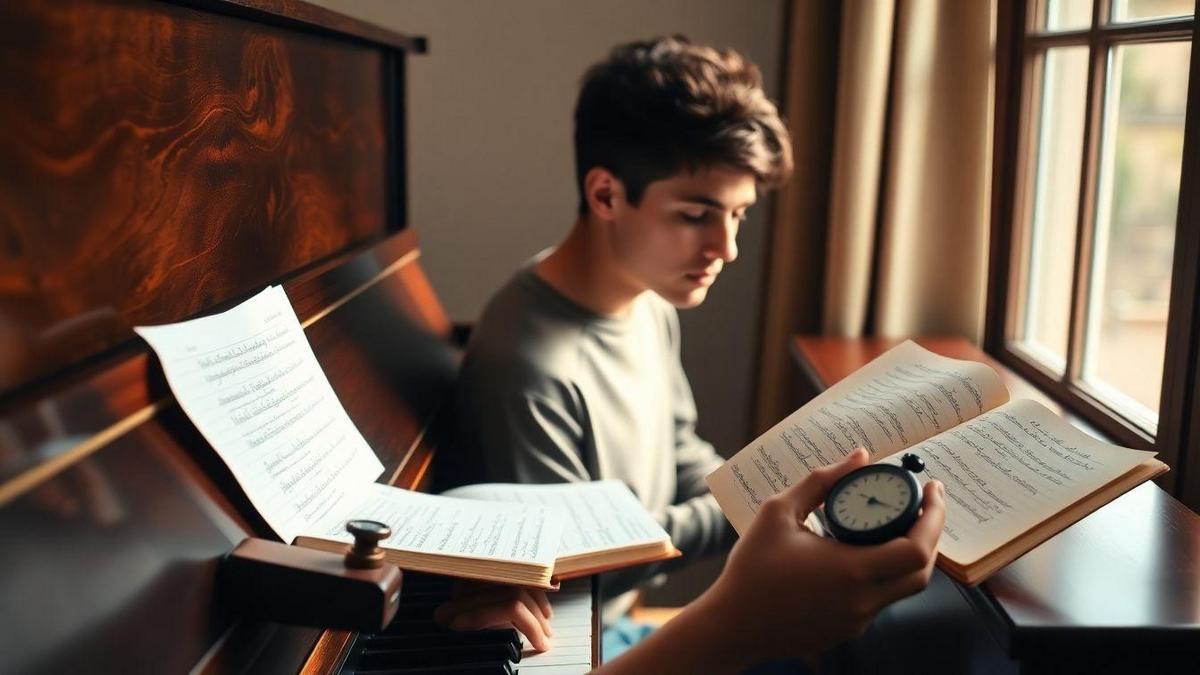
Tools that save time
Learning music with little free time: yes, it’s possible — and the right tools make each minute efficient.
Metronome, tuner, and slow-down apps:
- Metronome every session; set subdivisions and odd tempos as needed (see practical metronome tips). Learn How metronomes support accurate timing.
- Tuner gets you ready in 30 seconds. Tune fast and keep playing.
- Slow-down apps let you work tricky passages at half speed without changing pitch.
Looping and play-along features:
- Loop the exact bar that trips you up; repeat until fingers and ears agree.
- Play-along tracks simulate band settings and keep you engaged — helpful if you want to make practice feel more like play.
- Use loop length control, auto-repeat, and tempo slider to progress.
Save favorite exercises in apps for quick access:
- Create a short playlist of warm-ups, technique drills, tricky phrases, and song chunks.
- Label presets clearly (Warm 2 min, Arp 80%).
- Use tags (#warmup, #speed) and update weekly.
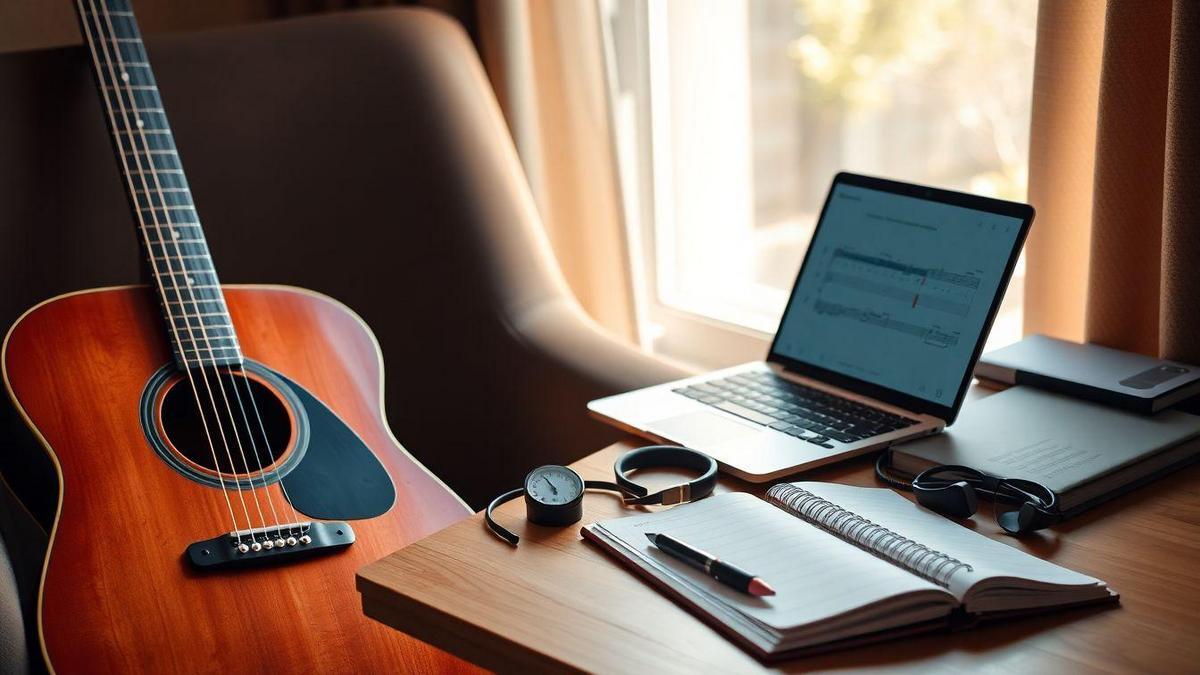
Time-saving tips I teach beginners
- Learn core skills first: rhythm/timing, basic chord shapes/scales, good posture. These prevent wasted months fixing bad habits — avoid common pitfalls in seven beginner mistakes that slow progress.
- Bite-sized lessons: five-minute wins (one bar, one chord change, one rhythm). Two short sessions beat one long, distracted session.
- Keep a one-page checklist: quick warm-up, main focus, song application, cool-down/record, set next mini-goal. Cross items off to feel progress.
Practice hacks for working adults
Habit-stacking: attach tiny music tasks to something you already do.
- Hum a short melody while brushing teeth (30–60 seconds).
- Sing a scale while the kettle boils.
- Practice finger shapes while folding laundry.
- Tap rhythm for two minutes before opening your laptop.
Using commute and breaks:
- Ear training on the bus with an app.
- Hum melodies while walking to improve timing and memory.
- On breaks, do 1–2 minute rhythm or sight-reading challenges on your phone.
- If driving, use mental practice: imagine fingerings or sing harmonies quietly.
Plan two mini-sessions daily and one weekly review:
- Morning mini (5–10 min): warm-up one skill.
- Evening mini (10–15 min): apply what you warmed up on.
- Weekly review (20–30 min): record a short clip, note one win and one next step.
If motivation lags, strategies in staying motivated when progress feels slow and ways to beat procrastination can help.

Choosing an instrument when time is limited
Pick instruments with fast wins and low setup so practice doesn’t disappear.
Good options:
- Ukulele — few strings, simple chords, sounds great fast. See why in affordable beginner instruments.
- Small keyboard/MIDI — immediate notes, no tuning.
- Harmonica — pocket-sized, melodies quickly.
- Recorder or simple wind instruments — cheap and easy to learn tunes.
Test one month before committing:
- Week 1: basics — hold it, make sound, two chords/notes.
- Week 2: play a simple song.
- Week 3: build routine — five 10-minute sessions.
- Week 4: play with a backing track or friend.
If you’re unsure which instrument suits your style, check guitar, keyboard, or drums — which fits your style and how to choose your first instrument without regrets. Options for renting or buying are covered in renting vs buying your first instrument, and common myths are in the truth about easy instruments.
Ask: Do I enjoy practice? Am I making steady progress? Can I fit this into my day? If yes, keep going; if not, shrink goals or change instruments. Remember: Learning music with little free time: yes, it’s possible — a one-month test proves it.
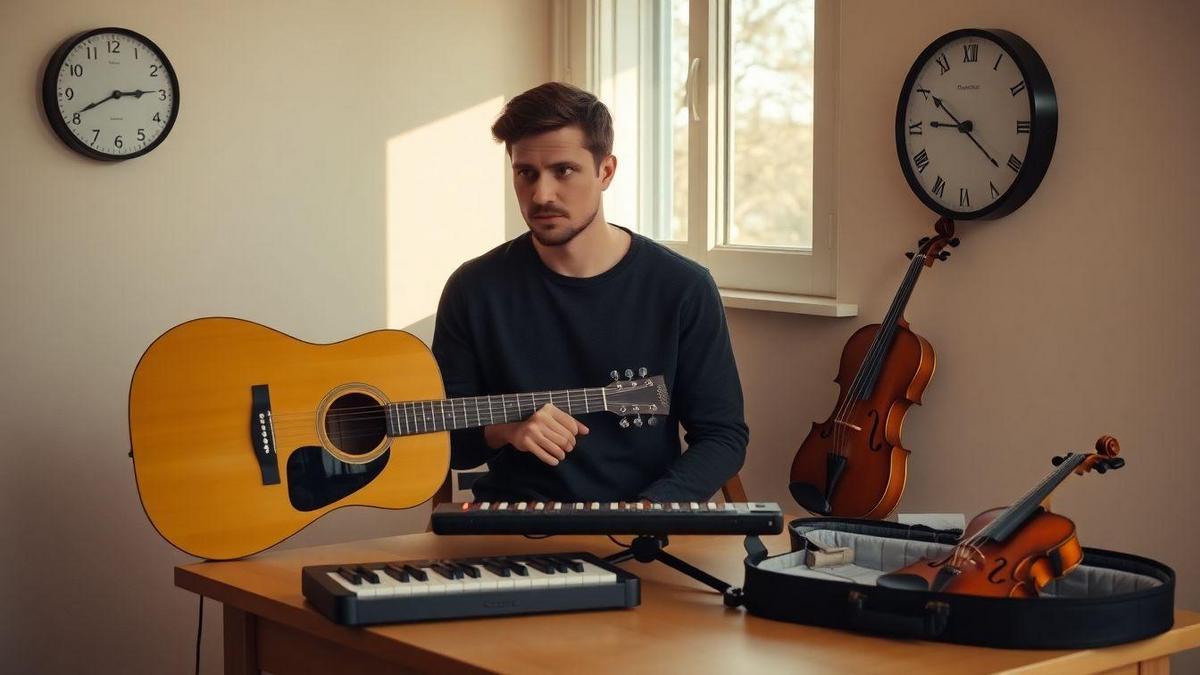
Daily mini exercises I return to
Short focused drills for ear, scale, and rhythm work.
Simple ear training / scale drills (5 minutes):
- Sing or hum one interval: pick two notes, hum each, name the interval — get started with musical intervals made simple.
- Call-and-response: sing back a two-note phrase from an app.
- Scale sweep: sing/play a major or minor scale slowly once (scales explained).
- Melody recall: listen to a 30-second clip, then sing it back — practice ear skills in playing by ear.
Rhythm and timing minis:
- Metronome heartbeat: tap or clap quarter notes for one minute.
- Subdivision practice: count 1-and-2-and… then switch to triplets.
- Accent game: clap a steady eight counts and place accents on different beats.
- Rhythmic echo: clap a 4-beat pattern and repeat it back exactly.
Record a 30–60 second clip daily:
- Use your phone, label the file with the date, listen back, and note one thing to fix tomorrow. Recording turns practice into a conversation with yourself and helps you turn mistakes into learning opportunities.
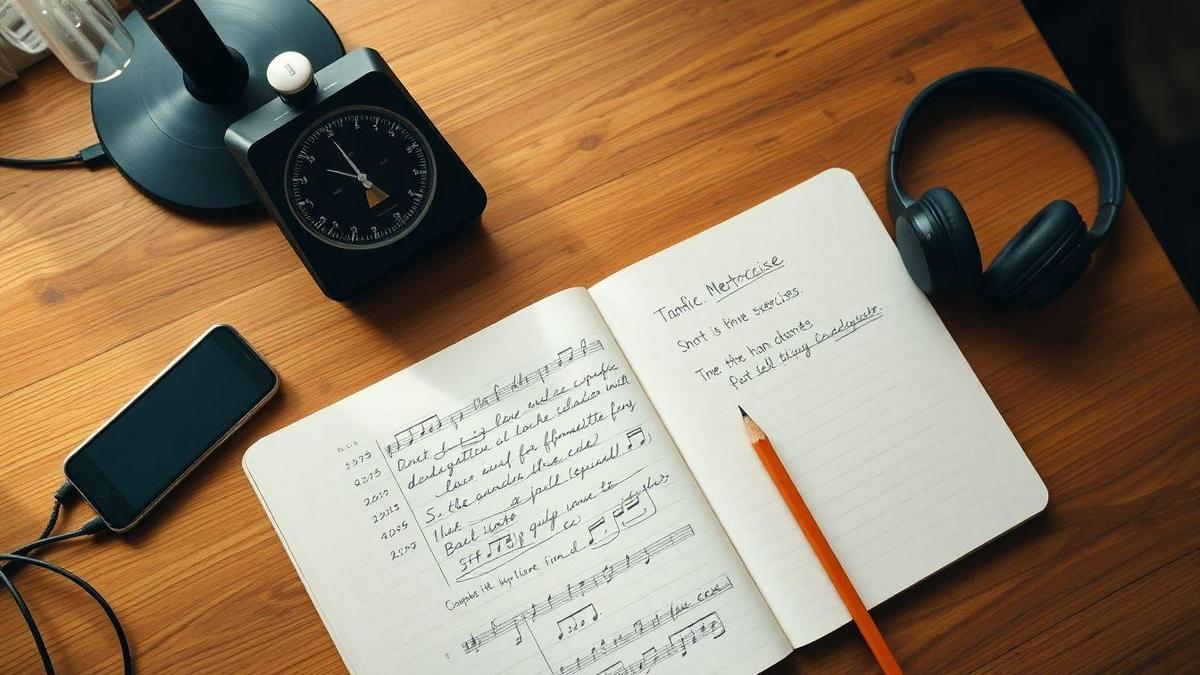
How I optimize a practice schedule
Set tiny measurable goals and track minutes, not perfection.
- Make goals specific: play chord changes cleanly for 8 minutes.
- Measure minutes and log them. A simple timer is enough.
- Weekly reviews: total minutes per focus area, one win, one sticking point, and three tiny goals for next week.
- Celebrate small wins: log the date, minutes, and one achievement (Mon — 20 min — nailed bar 5). Small rewards keep momentum — remember that consistency beats raw talent.
If you want a slightly longer routine, read about recommended daily timings in how much time per day for music.
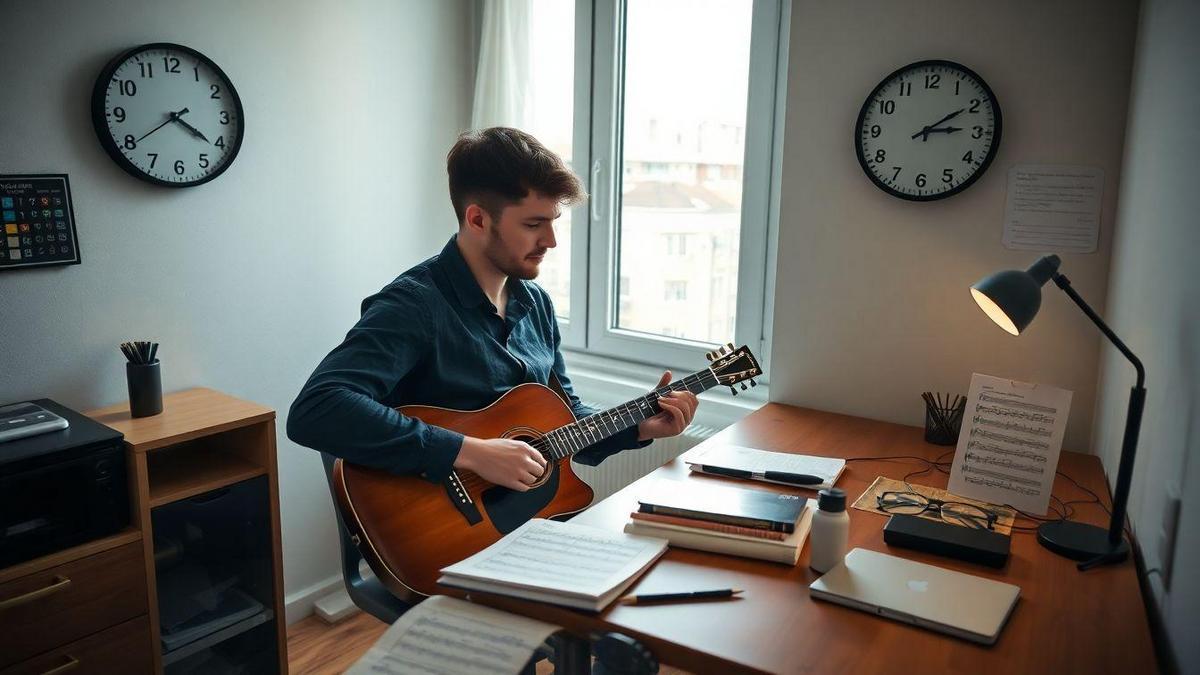
Conclusion
I get how tight your schedule can be. I’ve been there. That’s why I keep things short, simple, and kind. Ten minutes, two minutes, or one clear goal — those tiny steps add up. I use short sessions, micro practice, and habit stacking to turn scraps of time into steady progress. Use a timer, a metronome, quick recordings for feedback, and a short log to celebrate wins.
Practice doesn’t need to be heroic. Consistency beats intensity. Drop pebbles into the pond of practice every day: some days are big splashes, most are small rings — both move the water. Learning music with little free time: yes, it’s possible. Start small, be patient, and track the tiny wins. For other quick mindset shifts and tips, see what I wish I had known.
If you want more tips like these, read more at https://clickneutro.com.
Frequently asked questions
Q: How can I practice music with only 10 minutes a day?
A: Pick one tiny skill and use a 5–10 minute timer. Warm up 1–2 minutes, focus 6–8 minutes on the chosen task, and finish by playing a short phrase. Small daily reps beat none — and you can compare different time approaches in short daily practice strategies.
Q: How do I learn full songs when I’m so busy?
A: Chop songs into tiny chunks (one bar or phrase). Loop the hardest bar at slow speed until clean, then add adjacent bars. Gradually stitch chunks together. Also useful: the mindset shift in playing vs practicing and how to turn mistakes into learning opportunities.
Q: How do I stay motivated with little free time?
A: Set tiny, clear goals and mark one small win each day. Habit cues (instrument in sight, labeled alarms) and a short practice log make momentum visible and rewarding. If progress feels slow, try tactics from staying motivated when progress feels slow and making practice fun instead of a chore.
